Buildings.Fluid.HeatPumps
Information
This package contains component models for heat pumps.
Extends from Modelica.Icons.VariantsPackage (Icon for package containing variants).
Package Content
| Name | Description |
|---|---|
| Heat pump with prescribed condenser leaving temperature and performance curve adjusted based on Carnot efficiency | |
| Reversible heat pump with performance curve adjusted based on Carnot efficiency | |
| Model for a reciprocating water to water heat pump | |
| Model for a scroll water to water heat pump | |
| Package for calibration of heat pump models | |
| Package with compressor models | |
| Package with model parameters for heat pumps | |
| Collection of models that illustrate model use and test models | |
| Collection of models that validate the heat pump models | |
| Package with base classes for Buildings.Fluid.HeatPumps |
 Buildings.Fluid.HeatPumps.Carnot_TCon
Buildings.Fluid.HeatPumps.Carnot_TCon
Heat pump with prescribed condenser leaving temperature and performance curve adjusted based on Carnot efficiency
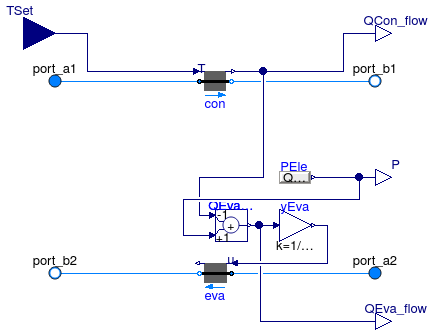
Information
This is a model of a heat pump whose coefficient of performance COP changes with temperatures in the same way as the Carnot efficiency changes. The control input is the setpoint of the condenser leaving temperature, which is met exactly at steady state if the heat pump has sufficient capacity.
The model allows to either specify the Carnot effectivness ηCarnot,0, or a COP0 at the nominal conditions, together with the evaporator temperature Teva,0 and the condenser temperature Tcon,0, in which case the model computes the Carnot effectivness as
ηCarnot,0 = COP0 ⁄ (Tcon,0 ⁄ (Tcon,0-Teva,0)).
The heat pump COP is computed as the product
COP = ηCarnot,0 COPCarnot ηPL,
where COPCarnot is the Carnot efficiency and ηPL is a polynomial in heating part load ratio yPL that can be used to take into account a change in COP at part load conditions. This polynomial has the form
ηPL = a1 + a2 yPL + a3 yPL2 + ...
where the coefficients ai
are declared by the parameter a.
On the Dynamics tag, the model can be parametrized to compute a transient
or steady-state response.
The transient response of the model is computed using a first
order differential equation for the evaporator and condenser fluid volumes.
The heat pump outlet temperatures are equal to the temperatures of these lumped volumes.
Typical use and important parameters
When using this component, make sure that the condenser has sufficient mass flow rate. Based on the evaporator mass flow rate, temperature difference and the efficiencies, the model computes how much heat will be removed by to the evaporator. If the mass flow rate is too small, very low outlet temperatures can result, possibly below freezing.
The condenser heat flow rate QCon_flow_nominal is used to assign
the default value for the mass flow rates, which are used for the pressure drop
calculations.
It is also used to compute the part load efficiency.
Hence, make sure that QCon_flow_nominal is set to a reasonable value.
The maximum heating capacity is set by the parameter QCon_flow_max,
which is by default set to infinity.
The coefficient of performance depends on the evaporator and condenser leaving temperature since otherwise the second law of thermodynamics may be violated.
Notes
For a similar model that can be used as a chiller, see Buildings.Fluid.Chillers.Examples.Carnot_TEva.
Extends from Buildings.Fluid.Chillers.BaseClasses.PartialCarnot_T (Partial model for chiller with performance curve adjusted based on Carnot efficiency).
Parameters
| Type | Name | Default | Description |
|---|---|---|---|
| replaceable package Medium1 | PartialMedium | Medium 1 in the component | |
| replaceable package Medium2 | PartialMedium | Medium 2 in the component | |
| HeatFlowRate | QCon_flow_max | Modelica.Constants.inf | Maximum heat flow rate for heating (positive) [W] |
| Nominal condition | |||
| MassFlowRate | m1_flow_nominal | QCon_flow_nominal/cp1_defaul... | Nominal mass flow rate [kg/s] |
| MassFlowRate | m2_flow_nominal | QEva_flow_nominal/cp2_defaul... | Nominal mass flow rate [kg/s] |
| HeatFlowRate | QEva_flow_nominal | -QCon_flow_nominal*(COP_nomi... | Nominal cooling heat flow rate (QEva_flow_nominal < 0) [W] |
| HeatFlowRate | QCon_flow_nominal | Nominal heating flow rate [W] | |
| TemperatureDifference | dTEva_nominal | -10 | Temperature difference evaporator outlet-inlet [K] |
| TemperatureDifference | dTCon_nominal | 10 | Temperature difference condenser outlet-inlet [K] |
| Pressure | dp1_nominal | Pressure difference over condenser [Pa] | |
| Pressure | dp2_nominal | Pressure difference over evaporator [Pa] | |
| Efficiency | |||
| Boolean | use_eta_Carnot_nominal | true | Set to true to use Carnot effectiveness etaCarnot_nominal rather than COP_nominal |
| Real | etaCarnot_nominal | COP_nominal/(TUse_nominal/(T... | Carnot effectiveness (=COP/COP_Carnot) used if use_eta_Carnot_nominal = true [1] |
| Real | COP_nominal | etaCarnot_nominal*TUse_nomin... | Coefficient of performance at TEva_nominal and TCon_nominal, used if use_eta_Carnot_nominal = false [1] |
| Temperature | TCon_nominal | 303.15 | Condenser temperature used to compute COP_nominal if use_eta_Carnot_nominal=false [K] |
| Temperature | TEva_nominal | 278.15 | Evaporator temperature used to compute COP_nominal if use_eta_Carnot_nominal=false [K] |
| Real | a[:] | {1} | Coefficients for efficiency curve (need p(a=a, yPL=1)=1) |
| Assumptions | |||
| Boolean | allowFlowReversal1 | true | = false to simplify equations, assuming, but not enforcing, no flow reversal for medium 1 |
| Boolean | allowFlowReversal2 | true | = false to simplify equations, assuming, but not enforcing, no flow reversal for medium 2 |
| Advanced | |||
| MassFlowRate | m1_flow_small | 1E-4*abs(m1_flow_nominal) | Small mass flow rate for regularization of zero flow [kg/s] |
| MassFlowRate | m2_flow_small | 1E-4*abs(m2_flow_nominal) | Small mass flow rate for regularization of zero flow [kg/s] |
| Boolean | homotopyInitialization | true | = true, use homotopy method |
| Diagnostics | |||
| Boolean | show_T | false | = true, if actual temperature at port is computed |
| Flow resistance | |||
| Condenser | |||
| Boolean | from_dp1 | false | = true, use m_flow = f(dp) else dp = f(m_flow) |
| Boolean | linearizeFlowResistance1 | false | = true, use linear relation between m_flow and dp for any flow rate |
| Real | deltaM1 | 0.1 | Fraction of nominal flow rate where flow transitions to laminar [1] |
| Evaporator | |||
| Boolean | from_dp2 | false | = true, use m_flow = f(dp) else dp = f(m_flow) |
| Boolean | linearizeFlowResistance2 | false | = true, use linear relation between m_flow and dp for any flow rate |
| Real | deltaM2 | 0.1 | Fraction of nominal flow rate where flow transitions to laminar [1] |
| Dynamics | |||
| Condenser | |||
| Time | tau1 | 60 | Time constant at nominal flow rate (used if energyDynamics1 <> Modelica.Fluid.Types.Dynamics.SteadyState) [s] |
| Temperature | T1_start | Medium1.T_default | Initial or guess value of set point [K] |
| Evaporator | |||
| Time | tau2 | 60 | Time constant at nominal flow rate (used if energyDynamics2 <> Modelica.Fluid.Types.Dynamics.SteadyState) [s] |
| Temperature | T2_start | Medium2.T_default | Initial or guess value of set point [K] |
| Evaporator and condenser | |||
| Dynamics | energyDynamics | Modelica.Fluid.Types.Dynamic... | Type of energy balance: dynamic (3 initialization options) or steady state |
Connectors
| Type | Name | Description |
|---|---|---|
| FluidPort_a | port_a1 | Fluid connector a1 (positive design flow direction is from port_a1 to port_b1) |
| FluidPort_b | port_b1 | Fluid connector b1 (positive design flow direction is from port_a1 to port_b1) |
| FluidPort_a | port_a2 | Fluid connector a2 (positive design flow direction is from port_a2 to port_b2) |
| FluidPort_b | port_b2 | Fluid connector b2 (positive design flow direction is from port_a2 to port_b2) |
| output RealOutput | QCon_flow | Actual heating heat flow rate added to fluid 1 [W] |
| output RealOutput | P | Electric power consumed by compressor [W] |
| output RealOutput | QEva_flow | Actual cooling heat flow rate removed from fluid 2 [W] |
| input RealInput | TSet | Condenser leaving water temperature [K] |
Modelica definition
 Buildings.Fluid.HeatPumps.Carnot_y
Buildings.Fluid.HeatPumps.Carnot_y
Reversible heat pump with performance curve adjusted based on Carnot efficiency
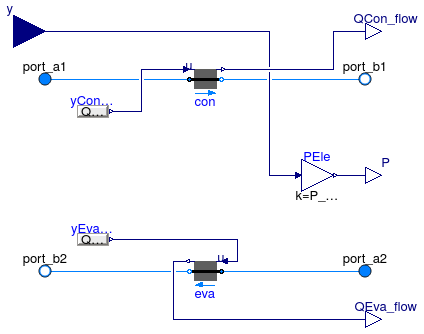
Information
This is model of a heat pump whose coefficient of performance COP changes with temperatures in the same way as the Carnot efficiency changes. The input signal y is the control signal for the compressor.
The model allows to either specify the Carnot effectivness ηCarnot,0, or a COP0 at the nominal conditions, together with the evaporator temperature Teva,0 and the condenser temperature Tcon,0, in which case the model computes the Carnot effectivness as
ηCarnot,0 = COP0 ⁄ (Tcon,0 ⁄ (Tcon,0-Teva,0)).
The heat pump COP is computed as the product
COP = ηCarnot,0 COPCarnot ηPL,
where COPCarnot is the Carnot efficiency and ηPL is a polynomial in the heating part load ratio yPL that can be used to take into account a change in COP at part load conditions. This polynomial has the form
ηPL = a1 + a2 yPL + a3 yPL2 + ...
where the coefficients ai are declared by the parameter a.
On the Dynamics tag, the model can be parametrized to compute a transient
or steady-state response.
The transient response of the model is computed using a first
order differential equation for the evaporator and condenser fluid volumes.
The heat pump outlet temperatures are equal to the temperatures of these lumped volumes.
Typical use and important parameters
When using this component, make sure that the evaporator and the condenser have sufficient mass flow rate. Based on the mass flow rates, the compressor power, temperature difference and the efficiencies, the model computes how much heat will be added to the condenser and removed at the evaporator. If the mass flow rates are too small, very high temperature differences can result.
The condenser heat flow rate QCon_flow_nominal is used to assign
the default value for the mass flow rates, which are used for the pressure drop
calculations.
It is also used to compute the part load efficiency.
Hence, make sure that QCon_flow_nominal is set to a reasonable value.
The maximum heating capacity is set by the parameter QCon_flow_max,
which is by default set to infinity.
The coefficient of performance depends on the evaporator and condenser leaving temperature since otherwise the second law of thermodynamics may be violated.
Notes
For a similar model that can be used as a chiller, see Buildings.Fluid.Chillers.Carnot_y.
Extends from Buildings.Fluid.Chillers.BaseClasses.PartialCarnot_y (Partial chiller model with performance curve adjusted based on Carnot efficiency).
Parameters
| Type | Name | Default | Description |
|---|---|---|---|
| replaceable package Medium1 | PartialMedium | Medium 1 in the component | |
| replaceable package Medium2 | PartialMedium | Medium 2 in the component | |
| Nominal condition | |||
| MassFlowRate | m1_flow_nominal | QCon_flow_nominal/cp1_defaul... | Nominal mass flow rate [kg/s] |
| MassFlowRate | m2_flow_nominal | QEva_flow_nominal/cp2_defaul... | Nominal mass flow rate [kg/s] |
| TemperatureDifference | dTEva_nominal | -10 | Temperature difference evaporator outlet-inlet [K] |
| TemperatureDifference | dTCon_nominal | 10 | Temperature difference condenser outlet-inlet [K] |
| Pressure | dp1_nominal | Pressure difference over condenser [Pa] | |
| Pressure | dp2_nominal | Pressure difference over evaporator [Pa] | |
| Power | P_nominal | Nominal compressor power (at y=1) [W] | |
| Efficiency | |||
| Boolean | use_eta_Carnot_nominal | true | Set to true to use Carnot effectiveness etaCarnot_nominal rather than COP_nominal |
| Real | etaCarnot_nominal | COP_nominal/(TUse_nominal/(T... | Carnot effectiveness (=COP/COP_Carnot) used if use_eta_Carnot_nominal = true [1] |
| Real | COP_nominal | etaCarnot_nominal*TUse_nomin... | Coefficient of performance at TEva_nominal and TCon_nominal, used if use_eta_Carnot_nominal = false [1] |
| Temperature | TCon_nominal | 303.15 | Condenser temperature used to compute COP_nominal if use_eta_Carnot_nominal=false [K] |
| Temperature | TEva_nominal | 278.15 | Evaporator temperature used to compute COP_nominal if use_eta_Carnot_nominal=false [K] |
| Real | a[:] | {1} | Coefficients for efficiency curve (need p(a=a, yPL=1)=1) |
| Assumptions | |||
| Boolean | allowFlowReversal1 | true | = false to simplify equations, assuming, but not enforcing, no flow reversal for medium 1 |
| Boolean | allowFlowReversal2 | true | = false to simplify equations, assuming, but not enforcing, no flow reversal for medium 2 |
| Advanced | |||
| MassFlowRate | m1_flow_small | 1E-4*abs(m1_flow_nominal) | Small mass flow rate for regularization of zero flow [kg/s] |
| MassFlowRate | m2_flow_small | 1E-4*abs(m2_flow_nominal) | Small mass flow rate for regularization of zero flow [kg/s] |
| Boolean | homotopyInitialization | true | = true, use homotopy method |
| Diagnostics | |||
| Boolean | show_T | false | = true, if actual temperature at port is computed |
| Flow resistance | |||
| Condenser | |||
| Boolean | from_dp1 | false | = true, use m_flow = f(dp) else dp = f(m_flow) |
| Boolean | linearizeFlowResistance1 | false | = true, use linear relation between m_flow and dp for any flow rate |
| Real | deltaM1 | 0.1 | Fraction of nominal flow rate where flow transitions to laminar [1] |
| Evaporator | |||
| Boolean | from_dp2 | false | = true, use m_flow = f(dp) else dp = f(m_flow) |
| Boolean | linearizeFlowResistance2 | false | = true, use linear relation between m_flow and dp for any flow rate |
| Real | deltaM2 | 0.1 | Fraction of nominal flow rate where flow transitions to laminar [1] |
| Dynamics | |||
| Condenser | |||
| Time | tau1 | 60 | Time constant at nominal flow rate (used if energyDynamics1 <> Modelica.Fluid.Types.Dynamics.SteadyState) [s] |
| Temperature | T1_start | Medium1.T_default | Initial or guess value of set point [K] |
| Evaporator | |||
| Time | tau2 | 60 | Time constant at nominal flow rate (used if energyDynamics2 <> Modelica.Fluid.Types.Dynamics.SteadyState) [s] |
| Temperature | T2_start | Medium2.T_default | Initial or guess value of set point [K] |
| Evaporator and condenser | |||
| Dynamics | energyDynamics | Modelica.Fluid.Types.Dynamic... | Type of energy balance: dynamic (3 initialization options) or steady state |
Connectors
| Type | Name | Description |
|---|---|---|
| FluidPort_a | port_a1 | Fluid connector a1 (positive design flow direction is from port_a1 to port_b1) |
| FluidPort_b | port_b1 | Fluid connector b1 (positive design flow direction is from port_a1 to port_b1) |
| FluidPort_a | port_a2 | Fluid connector a2 (positive design flow direction is from port_a2 to port_b2) |
| FluidPort_b | port_b2 | Fluid connector b2 (positive design flow direction is from port_a2 to port_b2) |
| output RealOutput | QCon_flow | Actual heating heat flow rate added to fluid 1 [W] |
| output RealOutput | P | Electric power consumed by compressor [W] |
| output RealOutput | QEva_flow | Actual cooling heat flow rate removed from fluid 2 [W] |
| input RealInput | y | Part load ratio of compressor [1] |
Modelica definition
 Buildings.Fluid.HeatPumps.ReciprocatingWaterToWater
Buildings.Fluid.HeatPumps.ReciprocatingWaterToWater
Model for a reciprocating water to water heat pump
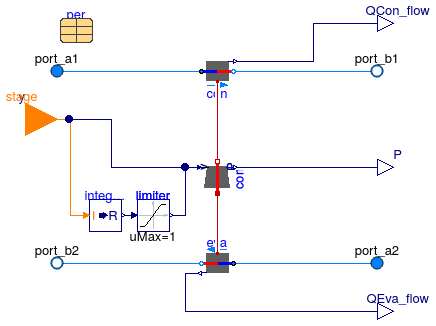
Information
Model for a water to water heat pump with a reciprocating compressor, as described in Jin (2002). The thermodynamic heat pump cycle is represented below.
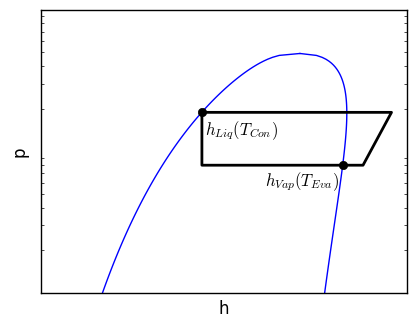
The rate of heat transfered to the evaporator is given by:
Q̇Eva = ṁref ( hVap(TEva) - hLiq(TCon) ).
The power consumed by the compressor is given by a linear efficiency relation:
P = PTheoretical / η + PLoss,constant.
Heat transfer in the evaporator and condenser is calculated using an ε-NTU method, assuming constant refrigerant temperature and constant heat transfer coefficient between fluid and refrigerant.
Variable speed is acheived by multiplying the full load piston displacement by the normalized compressor speed. The power and heat transfer rates are forced to zero if the resulting heat pump state has higher evaporating pressure than condensing pressure.
Assumptions and limitations
The compression process is assumed isentropic. The thermal energy of superheating is ignored in the evaluation of the heat transfered to the refrigerant in the evaporator. There is no supercooling.
References
H. Jin. Parameter estimation based models of water source heat pumps. PhD Thesis. Oklahoma State University. Stillwater, Oklahoma, USA. 2012.
Extends from Buildings.Fluid.HeatPumps.BaseClasses.PartialWaterToWater (Partial model for water to water heat pumps and chillers).
Parameters
| Type | Name | Default | Description |
|---|---|---|---|
| replaceable package Medium1 | PartialMedium | Medium 1 in the component | |
| replaceable package Medium2 | PartialMedium | Medium 2 in the component | |
| replaceable package ref | R410A | Refrigerant in the component | |
| Boolean | enable_variable_speed | true | Set to true to allow modulating of compressor speed |
| Real | scaling_factor | 1.0 | Scaling factor for heat pump capacity |
| ThermalConductance | UACon | per.UACon*scaling_factor | Thermal conductance of condenser [W/K] |
| ThermalConductance | UAEva | per.UAEva*scaling_factor | Thermal conductance of evaporator [W/K] |
| Generic | per | Heat pump performance data | |
| Nominal condition | |||
| MassFlowRate | m1_flow_nominal | Nominal mass flow rate [kg/s] | |
| MassFlowRate | m2_flow_nominal | Nominal mass flow rate [kg/s] | |
| PressureDifference | dp1_nominal | Pressure difference [Pa] | |
| PressureDifference | dp2_nominal | Pressure difference [Pa] | |
| Assumptions | |||
| Boolean | allowFlowReversal1 | true | = false to simplify equations, assuming, but not enforcing, no flow reversal for medium 1 |
| Boolean | allowFlowReversal2 | true | = false to simplify equations, assuming, but not enforcing, no flow reversal for medium 2 |
| Advanced | |||
| MassFlowRate | m1_flow_small | 1E-4*abs(m1_flow_nominal) | Small mass flow rate for regularization of zero flow [kg/s] |
| MassFlowRate | m2_flow_small | 1E-4*abs(m2_flow_nominal) | Small mass flow rate for regularization of zero flow [kg/s] |
| Boolean | homotopyInitialization | true | = true, use homotopy method |
| Diagnostics | |||
| Boolean | show_T | false | = true, if actual temperature at port is computed |
| Flow resistance | |||
| Medium 1 | |||
| Boolean | from_dp1 | false | = true, use m_flow = f(dp) else dp = f(m_flow) |
| Boolean | linearizeFlowResistance1 | false | = true, use linear relation between m_flow and dp for any flow rate |
| Real | deltaM1 | 0.1 | Fraction of nominal flow rate where flow transitions to laminar |
| Medium 2 | |||
| Boolean | from_dp2 | false | = true, use m_flow = f(dp) else dp = f(m_flow) |
| Boolean | linearizeFlowResistance2 | false | = true, use linear relation between m_flow and dp for any flow rate |
| Real | deltaM2 | 0.1 | Fraction of nominal flow rate where flow transitions to laminar |
| Dynamics | |||
| Condenser | |||
| Time | tau1 | 60 | Time constant at nominal flow rate (used if energyDynamics1 <> Modelica.Fluid.Types.Dynamics.SteadyState) [s] |
| Temperature | T1_start | Medium1.T_default | Initial or guess value of set point [K] |
| Evaporator | |||
| Time | tau2 | 60 | Time constant at nominal flow rate (used if energyDynamics2 <> Modelica.Fluid.Types.Dynamics.SteadyState) [s] |
| Temperature | T2_start | Medium2.T_default | Initial or guess value of set point [K] |
| Evaporator and condenser | |||
| Dynamics | energyDynamics | Modelica.Fluid.Types.Dynamic... | Type of energy balance: dynamic (3 initialization options) or steady state |
Connectors
| Type | Name | Description |
|---|---|---|
| FluidPort_a | port_a1 | Fluid connector a1 (positive design flow direction is from port_a1 to port_b1) |
| FluidPort_b | port_b1 | Fluid connector b1 (positive design flow direction is from port_a1 to port_b1) |
| FluidPort_a | port_a2 | Fluid connector a2 (positive design flow direction is from port_a2 to port_b2) |
| FluidPort_b | port_b2 | Fluid connector b2 (positive design flow direction is from port_a2 to port_b2) |
| input RealInput | y | Modulating signal for compressor frequency, equal to 1 at full load condition [1] |
| input IntegerInput | stage | Current stage of the heat pump, equal to 1 at full load condition |
| output RealOutput | QCon_flow | Actual heating heat flow rate added to fluid 1 [W] |
| output RealOutput | P | Electric power consumed by compressor [W] |
| output RealOutput | QEva_flow | Actual cooling heat flow rate removed from fluid 2 [W] |
Modelica definition
 Buildings.Fluid.HeatPumps.ScrollWaterToWater
Buildings.Fluid.HeatPumps.ScrollWaterToWater
Model for a scroll water to water heat pump
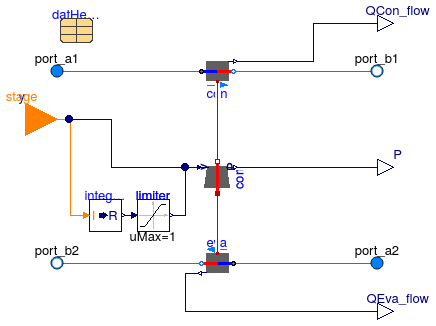
Information
Model for a water to water heat pump with a scroll compressor, as described in Jin (2002). The thermodynamic heat pump cycle is represented below.

The rate of heat transfered to the evaporator is given by:
Q̇Eva = ṁref ( hVap(TEva) - hLiq(TCon) ).
The power consumed by the compressor is given by a linear efficiency relation:
P = PTheoretical / η + PLoss,constant.
Heat transfer in the evaporator and condenser is calculated using an ε-NTU method, assuming constant refrigerant temperature and constant heat transfer coefficient between fluid and refrigerant.
Variable speed is achieved by multiplying the full load suction volume flow rate by the normalized compressor speed. The power and heat transfer rates are forced to zero if the resulting heat pump state has higher evaporating pressure than condensing pressure.
The model parameters are obtained by calibration of the heat pump model to manufacturer performance data. Calibrated model parameters for various heat pumps from different manufacturers are found in Buildings.Fluid.HeatPumps.Data.ScrollWaterToWater. The calibrated model is located in Buildings.Fluid.HeatPumps.Calibration.ScrollWaterToWater.
Assumptions and limitations
The compression process is assumed isentropic. The thermal energy of superheating is ignored in the evaluation of the heat transfered to the refrigerant in the evaporator. There is no supercooling.
References
H. Jin. Parameter estimation based models of water source heat pumps. PhD Thesis. Oklahoma State University. Stillwater, Oklahoma, USA. 2012.
Extends from Buildings.Fluid.HeatPumps.BaseClasses.PartialWaterToWater (Partial model for water to water heat pumps and chillers).
Parameters
| Type | Name | Default | Description |
|---|---|---|---|
| replaceable package Medium1 | PartialMedium | Medium 1 in the component | |
| replaceable package Medium2 | PartialMedium | Medium 2 in the component | |
| replaceable package ref | R410A | Refrigerant in the component | |
| Boolean | enable_variable_speed | true | Set to true to allow modulating of compressor speed |
| Real | scaling_factor | 1.0 | Scaling factor for heat pump capacity |
| ThermalConductance | UACon | datHeaPum.UACon*scaling_factor | Thermal conductance of condenser [W/K] |
| ThermalConductance | UAEva | datHeaPum.UAEva*scaling_factor | Thermal conductance of evaporator [W/K] |
| Generic | datHeaPum | Heat pump data | |
| Nominal condition | |||
| MassFlowRate | m1_flow_nominal | Nominal mass flow rate [kg/s] | |
| MassFlowRate | m2_flow_nominal | Nominal mass flow rate [kg/s] | |
| PressureDifference | dp1_nominal | Pressure difference [Pa] | |
| PressureDifference | dp2_nominal | Pressure difference [Pa] | |
| Assumptions | |||
| Boolean | allowFlowReversal1 | true | = false to simplify equations, assuming, but not enforcing, no flow reversal for medium 1 |
| Boolean | allowFlowReversal2 | true | = false to simplify equations, assuming, but not enforcing, no flow reversal for medium 2 |
| Advanced | |||
| MassFlowRate | m1_flow_small | 1E-4*abs(m1_flow_nominal) | Small mass flow rate for regularization of zero flow [kg/s] |
| MassFlowRate | m2_flow_small | 1E-4*abs(m2_flow_nominal) | Small mass flow rate for regularization of zero flow [kg/s] |
| Boolean | homotopyInitialization | true | = true, use homotopy method |
| Diagnostics | |||
| Boolean | show_T | false | = true, if actual temperature at port is computed |
| Flow resistance | |||
| Medium 1 | |||
| Boolean | from_dp1 | false | = true, use m_flow = f(dp) else dp = f(m_flow) |
| Boolean | linearizeFlowResistance1 | false | = true, use linear relation between m_flow and dp for any flow rate |
| Real | deltaM1 | 0.1 | Fraction of nominal flow rate where flow transitions to laminar |
| Medium 2 | |||
| Boolean | from_dp2 | false | = true, use m_flow = f(dp) else dp = f(m_flow) |
| Boolean | linearizeFlowResistance2 | false | = true, use linear relation between m_flow and dp for any flow rate |
| Real | deltaM2 | 0.1 | Fraction of nominal flow rate where flow transitions to laminar |
| Dynamics | |||
| Condenser | |||
| Time | tau1 | 60 | Time constant at nominal flow rate (used if energyDynamics1 <> Modelica.Fluid.Types.Dynamics.SteadyState) [s] |
| Temperature | T1_start | Medium1.T_default | Initial or guess value of set point [K] |
| Evaporator | |||
| Time | tau2 | 60 | Time constant at nominal flow rate (used if energyDynamics2 <> Modelica.Fluid.Types.Dynamics.SteadyState) [s] |
| Temperature | T2_start | Medium2.T_default | Initial or guess value of set point [K] |
| Evaporator and condenser | |||
| Dynamics | energyDynamics | Modelica.Fluid.Types.Dynamic... | Type of energy balance: dynamic (3 initialization options) or steady state |
Connectors
| Type | Name | Description |
|---|---|---|
| FluidPort_a | port_a1 | Fluid connector a1 (positive design flow direction is from port_a1 to port_b1) |
| FluidPort_b | port_b1 | Fluid connector b1 (positive design flow direction is from port_a1 to port_b1) |
| FluidPort_a | port_a2 | Fluid connector a2 (positive design flow direction is from port_a2 to port_b2) |
| FluidPort_b | port_b2 | Fluid connector b2 (positive design flow direction is from port_a2 to port_b2) |
| input RealInput | y | Modulating signal for compressor frequency, equal to 1 at full load condition [1] |
| input IntegerInput | stage | Current stage of the heat pump, equal to 1 at full load condition |
| output RealOutput | QCon_flow | Actual heating heat flow rate added to fluid 1 [W] |
| output RealOutput | P | Electric power consumed by compressor [W] |
| output RealOutput | QEva_flow | Actual cooling heat flow rate removed from fluid 2 [W] |
